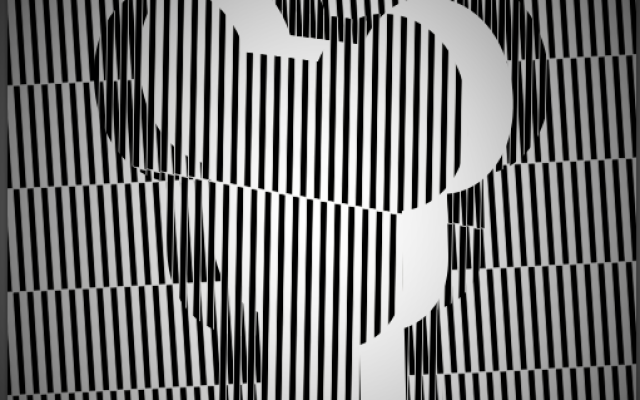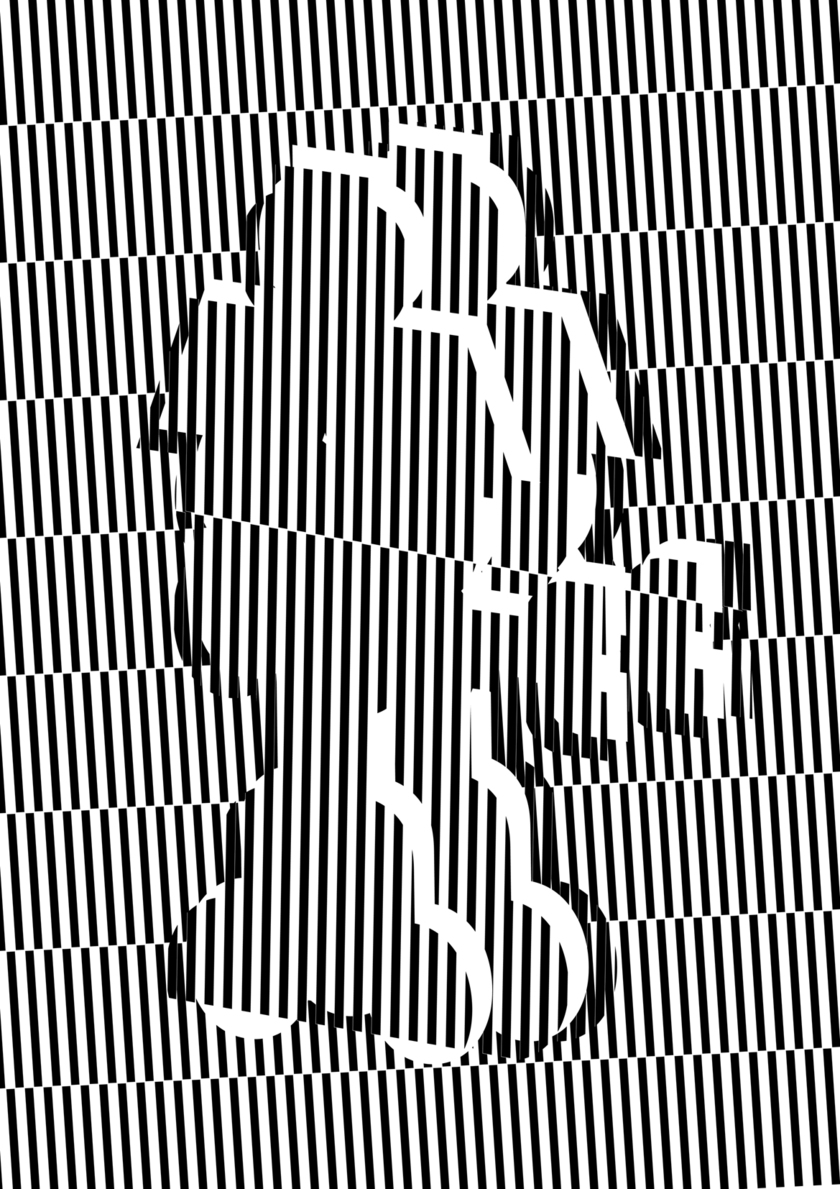
Animated image made by publication research studio Behind the X. (c) Behind the X
Introduction
In the present day, the concept of contingency usually denotes future unpredicted events for which one must be prepared. It is mainly used for management in business and administrative purposes, referring to the careful preparation and planning of organizations. It is a tool and solution for preventing and recovering from disasters and failures, a strategy to avoid risks and disruptions that might impact companies and corporations. It predicates the potential of accidents, hazards, incidents, injuries, and threats. Furthermore, it is employed as a tool to control, reduce risk and recuperate if any unforeseen event happens – a “plan B.”
Similarly, in the cultural sector, contingency is used in museums and cultural institutions as an implement to prevent accidents. It appears as the last element enlisted in budget templates – the 10–15 percent of funds designated for exhibitions and curatorial projects. It can also be traced in risk assessments, funding applications, relating to health and safety requirements and responding to control procedures for administrative purposes. It is subject to a series of institutional formalities, which act on standardized organizational forms. In the most immediate and practical sense, contingency in the cultural sector, indicates a fear towards the things that cannot be controlled and an anxiety towards that which is unknown.
Beyond its administrative use, nevertheless, contingency is a complicated concept, addressed by a variety of thinkers throughout the history of Western philosophy. It raises the greatest number of difficulties and ultimately poses questions of contradiction and paradox. It takes us back to Ancient Greece, deriving from Aristotle’s theory of potentiality and the debate about future contingents. It has to do with predictions and is traced in the undecided moment when the spoken or the written word (language) and the event or actual thing are separated and simultaneously united by time. Likewise, it is adjudicated with the ability to suspend truth and falsehood, any turn of judgement causing deferral between affirmations and denials, but also between words and things. It is located between actuality and potentiality, but also between what is known as potentiality-to-be (or do) and potentiality-not-to-be (or do).
Contingency is a challenging philosophical notion that Giorgio Agamben has widely studied. According to him, a thing’s capacity to be true and, at the same time not to be true (a being that can both be and not be), is said to be contingent. The contingent, the philosopher writes, coincides with the domain of human freedom in its opposition to necessity, and it has given rise the greatest number of difficulties in philosophy.1 Contingency is defined by its capacity to generate an uncertain and intermediary estate of being and non-being, which exists prior to the act of creation. It creates a suspension in time; generating ambiguity in the passage from potentiality to actuality. It triggers further discussions about human destiny and free will.
In the field of art, contingency has been explored through research and experimentation within correlated areas, which are closely affiliated and enrich the interpretation of this notion. Inspired by the ancient Chinese divination text of the I Ching or Book of Changes, John Cage employed chance procedures, random and indeterminate methods in his practice. Brian Eno and Peter Schmidt created the Oblique Strategies, a deck of cards intended to help artists break creative blocks by encouraging lateral thinking. Furthermore, Aby Warburg arranged his Atlas Mnemosyne around subjective affinities and associations of contents, settling new relationships between them. Harald Szeemann saw his exhibitions as an “archive in transformation” and his curatorial method as “structured chaos.”
These figures expose the existence of a variety of underlying and invisible instruments related to contingency, aim or by-product of artistic and curatorial making. The curiosity towards contingency, the passage from potentiality to actuality and the multiple possibilities for art to emerge has persisted in artistic/curatorial thought over time; this fascination has led to the development of different strategies within the creative field. For this reason, this essay is structured according to an association of concepts regarding the interpretation of contingency. It weaves a thread that goes through a brief analysis of Agamben and Aristotle’s philosophical interpretation of contingency, connecting with creative resources that experiment with it by addressing intuition, randomness and chance, intertwining with failure, and closing with resistance and non-production. It puts together a variety of entry points in the experimentation of contingency in relationship to contemporary art.
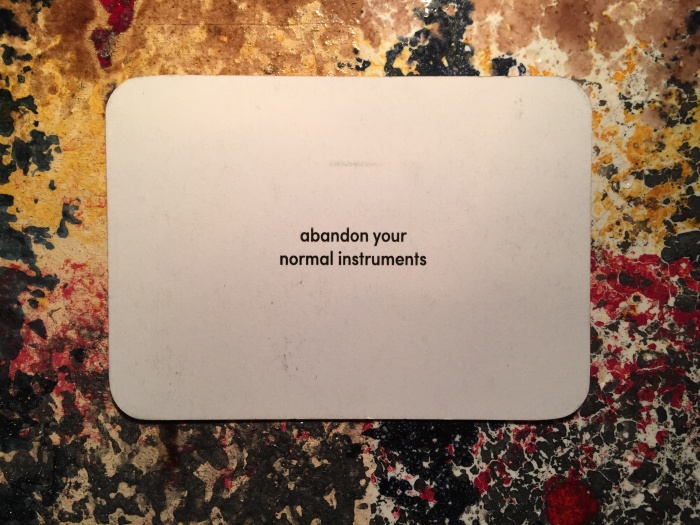
Jedna z kart talii Oblique Strategies (Over One Hundred Worthwhile Dilemmas), stworzona przez Briana Eno i Petera Schmidta, 1975. Zdjęcie: Paula Lopez Zambrano.

Jedna z kart talii Oblique Strategies (Over One Hundred Worthwhile Dilemmas), stworzona przez Briana Eno i Petera Schmidta, 1975. Zdjęcie: Paula Lopez Zambrano.
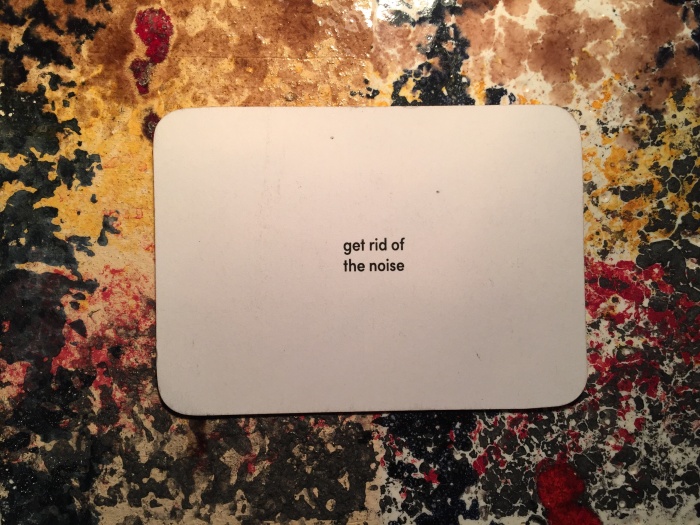
Jedna z kart talii Oblique Strategies (Over One Hundred Worthwhile Dilemmas), stworzona przez Briana Eno i Petera Schmidta, 1975. Zdjęcie: Paula Lopez Zambrano.
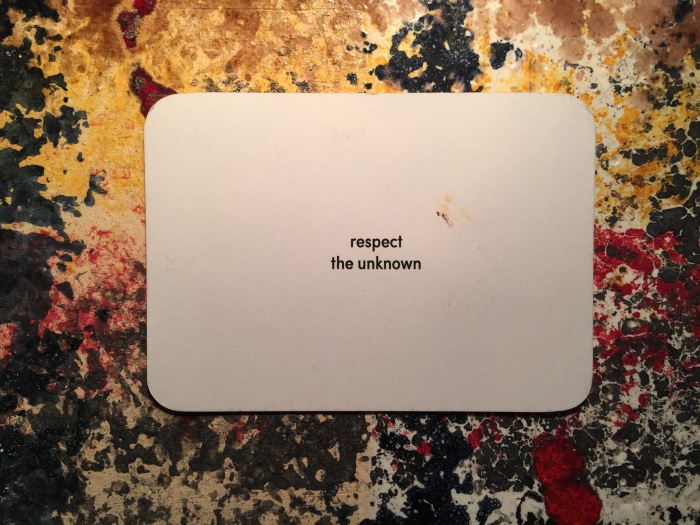
Jedna z kart talii Oblique Strategies (Over One Hundred Worthwhile Dilemmas), stworzona przez Briana Eno i Petera Schmidta, 1975. Zdjęcie: Paula Lopez Zambrano.
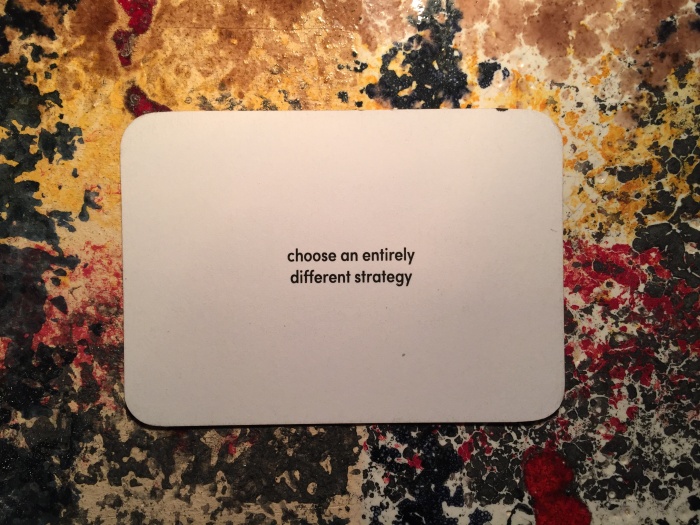
Jedna z kart talii Oblique Strategies (Over One Hundred Worthwhile Dilemmas), stworzona przez Briana Eno i Petera Schmidta, 1975. Zdjęcie: Paula Lopez Zambrano.
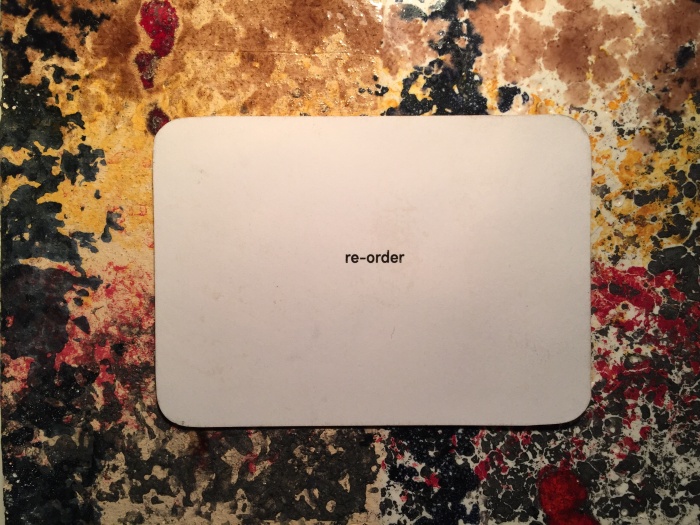
Jedna z kart talii Oblique Strategies (Over One Hundred Worthwhile Dilemmas), stworzona przez Briana Eno i Petera Schmidta, 1975. Zdjęcie: Paula Lopez Zambrano.
Philosophy
The philosophical debate concerning potentiality and contingency derives from Aristotle’s De Interpretatione. In this treatise, he analyses the true value of singular statements about future contingents: the contradictory pairs of statements, which divide truth and falsity, and raises the question of whether there might be an exception with respect to statements about singular future events, which are neither necessary, nor impossible, and may take place or may not. He gives the example of a sea-battle: “…it would have neither to happen nor not to happen…”2
In a general consensus, we tend to think of a future event as a possibility and not a necessity. Due to the fact that a future event exists in the future and not in the present, we do not know for certain if it will happen or not. However, if someone had made a prediction yesterday about a sea-battle tomorrow, that prediction, because it is in the past, is fixed by necessity and not by possibility. If we think that all past events necessarily happened or necessarily did not happen, it can be presumed that there are no predictions in the past that possibly happened and did not possibly happen. On the contrary, it could be assumed that predictions are not only possible (in the present) but rather necessary (in the past).
“A sea-battle will occur” and “a sea-battle will not occur” are contrary statements. They both have the potentiality to be either true or false and they both correspond to a future reality in which case the sea-battle will take place with necessity, or not take place with necessity. So it is not necessary for a sea-battle to occur and it is necessary for a sea-battle not to occur. In this case, both possibilities are open; consequently, both being and not being, both coming to be and not coming to be. Thus, when two opposite sentences are spoken at the same time, referring to a different period of time, truth and falsehood become annulated; time becomes suspended. To this paradigm, the Skeptics denoted their most characteristic experience: the epokhē or suspension of judgement; a condition when all action is suspended.
However, Aristotle digs into the analysis of actuality and potentiality in his Metaphysics: the former is assigned to existing things; the latter is designated to non-existing things (objects of thought and desire), which are things that exist but that, at the same time, do not exist as actual things. Hence, potentiality is defined by its possibility to not be enacted: it can be and it cannot be.
Giorgio Agamben develops a wide body of work in the interpretation of potentiality and contingency. He alludes to Aristotle’s investigations and refers to the image of a white table on which nothing is written: thought has the capacity to think but it also has the capacity to not-think.3 By making use of this passage, Agamben explains that the architect can build and the architect cannot build. One thing is to have a capacity or possess a potentiality, another is to exercise it or actualize that potentiality (one thing is to be a builder who is building, another thing is to be a builder who is not building but still has the skills and capacities to do so). However, for Agamben, men [or woman] who can exhort an act cannot exhort an act, simultaneously. And the metaphor of the writing table refers to the mind as a blank slate without any characters and without any ideas (a “clean slate” or “white sheet”): it symbolizes the kind of potentiality that can be actualized but is never actualized.4
Contingency can be defined, then, as a capacity of something (a thought, a thing, an event) to be simultaneously true and false, to be actualized and not be actualized; a capacity of something to be potentiality and be impotentiality. It exists between affirmation and negation. Contingency happens in Aristotle’s exception to the rule, in the “virtue of an ambiguity,” in the fields of contradiction and paradox. Contingency is the suspension located in the tension between actuality and potentiality, a tension that can only be expressed in a statement that can be both true and false. Thus the opposition “a sea-battle will occur”’ and a “sea-battle will not occur” transforms into the formula “a-sea-battle-will-occur-or-a-sea-battle-will-not-occur.”
But what concerns to this essay is the passage from potentiality to actuality and the question of the creative act. “…Who moves the scribe’s hand so that it will pass into actuality of writing? According to what laws does the transition from the possible to the real take place? And if there is something like possibility or potentiality, what – in it or outside it – causes it to exist? ...”5
In order to answer these questions, Agamben refers to two variables explained in Islam: the first variable is represented by the falasifa, who believed in the existence of laws, causes and principles by which potentiality, which exists in the mind of God or the artificer, does or does not take place within the creative act. Following Agamben’s analysis, the other variable is represented by the Asharites, who “…conceive the act of creation as an incessant and instantaneous production of miraculous accidents that cannot influence each other and that are, therefore, independent of all laws and causal relations….”6
Therefore, these two variables represent the opposition between the belief in a preconceived order (laws, causes and principles), which link with ideas of destiny and fate, and the acknowledgment of accident and contingency (miraculous accidents), which associate with ideas of freedom and luck. What interests us in this analysis are the miraculous accidents, the chance encounters, black holes, that layer of wax, that writing-table that is nothing but its own passivity, its own pure potentiality. The creative process transforms into an action when it crosses the bridge that communicates potentiality and actuality – where ideas, theories, compositions or texts, events, images or objects do, or do-not become actualized. The artistic process stages the transition from the inexpressible to the expressible. And it is precisely that bridge, that intermediate zone, where contingency is rooted and the multiple forms of becoming coexist. Therefore, the creative act contains a restless estate of contingency and there is a latent and silent tension that relies on the dichotomy potentiality/actuality. Under these circumstances, the curator, the architect or the artist can do and cannot do, but she/he also can choose and prefer to create, to curate, to investigate, produce, or build.
Is it possible to trace the hidden potential that belongs to art? What are the invisible forces that allow the transformation from potentiality to actuality?
The following artistic mechanisms have been wielded as sources of inspiration, artistic policy, structures of composition, and themes of representation. They endure as creative modes of research in artistic practice and the creative field, and they persist as research resources in the production of artistic knowledge. They involve aspects of coincidence and serendipity, improvisation and spontaneity, trust and uncertainty, the unconscious and perception, accident and mistake, expectation and dissatisfaction, refusal and withdraw; they ultimately lead to an encounter with unexpected and unimagined results.
Intuition, chance and randomness
Nothing is more frightening than not knowing where you’re going, but then again nothing can be more satisfying than finding you have arrived somewhere without any clear idea of the route.7
To begin this investigation, it is worth the reference to Carl Gustav Jung, who defined intuition as a psychological faculty: the faculty to perceive the unconscious, or insentient contents. Intuition, in the field of psychoanalysis, is understood as the capacity to gain awareness by bringing ideas, images, and possibilities forth. It opens ways out of blocked situations.8 Intuition is a mostly unconscious process, but also a rooted mode of existence to the creative process. It involves tacit experience, the use of the senses, and leads into an encounter with unknown potencies. Rather than focusing on the intellect, rational judgment, or logic, it implicates coincidence, chance, instinct, and trust.
There are multiple examples of artistic practices that make use of intuition, but the work of Tacita Dean serves as a good example of this process. One of her proposals (where the curatorial melted with the artistic practice), is the exhibition An Aside – commissioned by The Hayward Gallery as part of its series of artist-selected projects, including the work of seventeen international artists. The title alludes to the dramatic resource used when an actor speaks directly to the audience without affecting the action on the stage; it indicates unspoken thought. Under the parameters of intuition, she curated the exhibition as though she was writing a story based on erratic recollections of different elements: an exquisite corpse based on accidents and subjective associations. Without a fixed method, she worked among the conscious and the unconscious. Gathering the objects that she included through a chain of accidents, based in an associative process. For Dean, the appearance of what she considered ‘“whispers” became decisive moments in her curatorial script. The “in between” elements guided her practice as strategies that conditioned her process while gathering and selecting the artworks she decided to include. Without any predetermined script, and by means of chance, she found unexpected themes.9
A throw of the dice will never abolish chance
Stéphane Mallarmé
Dean’s use of chance is rooted in intuition, chance and coincidence. But these procedures vary from being highly systematic to more intuitive and informal. George Brecht, one of the most immediate references when thinking about the use of chance as a creative technique, formulated ideas about “chance method schemes.” He distinguished two types of chance: the first one results from consciously unknown causes; the second one results from some mechanical operation where human agency is bypassed. Subsequently, the origin of the first kind of chance is unknown because it lies in deeper-than-conscious levels of the mind. The second type of chance derives from mechanical processes not under the artist’s control.10 As an example, his performance of Drip Music, which used laboratory pipettes for the dripping, consisting of the sound of a container of water dribbling into a can. In this piece, the procedure of chance took place in the within a fixed setting, much like Eno and Schmidt Oblique Strategies, or Mallarmé’s pair of dice. Within those limitations, chance is set to happen with arbitrary outcomes.
Brecht’s mentor, John Cage, used chance equally involving planation and thinking. He is another inevitable reference when thinking about the use of random techniques associated with chance. Inspired by the divinatory I Ching or Book of Changes, the artist employed chance procedures, and indeterminate methods. The dynamic balance of opposites, the evolution of events as a process, and the acceptance of the inevitability of change, were central to his creative scheme. By making use of random numbers, chance operations or chance-determined marks, his method involved determination, the schematically “planned unpredictability,” rather than chaos or instinct.
As an example, the exhibition Rolywholyover, A Circus (1993) was curated by Julie Lazar and the artist himself; it was planned for the Museum of Contemporary Art in Los Angeles. Cage defined this project as a “composition for a museum,” and hoped it would produce an exhibition that was completely unrecognizable from visit to visit, suggesting alternative ways of being in a museum. He composed a four-movement traveling composition whose conditions of creation, his application of chance operations to the location and selection of artworks, followed the same random dictum as that applied to a piece of music.11
Failure
The book Failure, edited by Lisa Le Feuvre, connects the notion of failure to the arts. According to this author, through failure one has the potential to stumble on the unexpected. The notion of failure (like contingency) commonly denotes the events that should not take place. However, contingency is conventionally used as a resource to fix the failure, similar to a “Plan B.” Under these circumstances, contingency reveals the belief that failure can be avoided, managed, and controlled. But to follow the parameters of what is considered as a “success” means to fit into a system of values, but to break with these constraints suggest discovering alternative ways of experiencing and producing art.
Failure, in art, can also be a component of speculative experiment, which arrives at something unrecognizable as art according to the current criteria of knowledge and judgment. To work with failure means to be able to re-evaluate things that were previously rejected and to provoke a shift in a system of values and reconsider “forgotten” ideas, or things that were a priori denied.12
Le Feuvre refers to Julian Schnabel, who describes his work as a “boutique of mistakes.” Rather than producing a space for mediocrity, Schnabel’s failure becomes intrinsic to the creation of new systems and the search for questions. Without the doubt that failure invites, any situation becomes closed and in danger of becoming dogmatic. Art-making can be characterized as an activity where doubt lies in wait at every turn and where failing is not always unacceptable.13
I want my life to be embedded in my work, crushed into my paintings like a pressed car. If it’s not, my work is just some stuff. When I’m away from it, I’m crippled. Without my relationship to what may seem like these inanimate objects, I am just an indulgent misfit. If the spirit of being isn’t present in the face of this work, it should be destroyed because it’s meaningless. I am not making some things. I am making a synonym for the truth with all its falsehoods, oblique as it is. I am making icons that present life in terms of our death. A boutique of mistakes.14
Le Feuvre also argues that there is a gap between intention, expectation and realization in the production and creation of art. As examples, Dominique Gonzalez-Foerster’s De Novo (2009) – a video that shows the artist being asked to contribute to the biggest event on the art calendar for the fifth time – Gonzalez-Foerster describes her past ideas as ‘“black holes” that always seem to be unsatisfactorily realized. Similarly, David Critchley’s Pieces I Never Did (1979) – a video where the artist talks directly to the camera describing eighteen propositions for artworks, taking in performance, film, video, installation and sculpture, each one never moving beyond notes in a sketchbook – reveals the multiple possibilities for an idea to transform into an artwork.15
Resistance and non-production
There is a wide variety of practices that explore the critical potential of choosing not to be part of a system. These practices deal with the unknown field of non-production. Mick Wilson identifies these attitudes of refusal, withdraw, or negation.16 Examples like Keith Aruet’s Is it possible to do nothing as my contribution to this exhibition? (1970), a piece where the artist proposed to do nothing as his contribution for an exhibition at Camden Arts Centre. And Robert Barry’s Closed Gallery (1969), a piece consisting of three invitations to gallery shows in Amsterdam, Turin, and Los Angeles that informed its audience that during the exhibition, the gallery would be closed, demonstrate strategies for a rejection of productivity, of giving the spectacle, and holding back from the expectations. These cases of no-participation become a form of resistance, ultimately interrogating the conditions of the art system.17
But a more recent example of is Maria Eichhorn’s, 5 weeks, 25 days, 175 hours, presented in the Chisenhale Gallery in London in 2016. In this piece, the artist requested that the gallery’s staff withdraw their labor for the five weeks of the exhibition. None of Chisenhale’s employees worked during that period of time and the gallery and office were closed, implementing leisure and “free time” in the place of work. The artist examined the contemporary labor conditions, but she also gives a space to ‘“leisure,” which is not generally seen as a “productive” or “constructive” quality.
Furthermore, Harald Szeemann’s Museum of Obsessions consisted in a fictive museum that existed only in his head. It emerged as a critique of the conservatism of institutions of art and art history, and outlined the stakes of his curatorial practice. He explains:
I reacted to that [Documenta 5] by organizing a very intimate exhibition in an apartment called “Grand-Father,” which consisted of my grandfather's personal belongings, and the tools of his profession – he was a hairdresser, an artist. I arranged these things to create an environment that reflected my interpretation of who he was. I have always maintained that it is important to try new approaches.18
This also illustrates an attitude of disavowal and refusal, an awareness of the potentiality not-to, and a willingness to withdraw, of “I prefer not to.” “…[T]o consider respect for the interior museum of each one as the beginning of the passion for art does not mean to reject the material or to unlearn what is known to do…”19
To conclude
It is just as if prohibitions, barriers, thresholds and limits, had been set up in order to master, at least partly, the great proliferation of discourse, in order to remove from its richness its most dangerous part, and in order to organize its disorder according to figures which dodge what is most uncontrollable about it.20
Coming back to the point of departure of this essay, in the organizational and managerial sphere of the cultural sector, contingency designates the unknown. It appears as a percentage in budget templates, as a negative element which represents a backup towards unfavorable circumstances, for things that might go wrong. But the acknowledgment of these existing or non-existing incidents reveal the fragility of the institutional systems and the possibility that things might go “wrong”: the false appraisals and faulty calculations that give birth to the things that exist and have value for us.
Money, bureaucracy, rules, and administration are also determinant factors in the passage from potentiality to actuality; they limit the infinite choices, the unavoidable and the unmanageable presence of multiple potentialities within an exhibition. To have the means, a budget, fulfil the health and safety requirements, to have insurance, the right conditions, the good relations, the proper material and contracts are factors that limit the possibilities of art before becoming “art,” of exhibitions before they become “exhibitions.”
However, discontinuities are relevant as they break established orders and inaugurate pluralities that exceed and produce differences. These practices (or non-practices) represent, explore, and make use of contingency as a critical and creative instrument; they ultimately cancel contingency but allow the transformation or non-transformation from potentiality to actuality to occur. They shift the function of an administrative resource, by grasping invisible forces that support and opens new paths in the search for the hidden potential and underlying knowledge that belong to art.
BIO
Paula Lopez Zambrano is a curator, writer, and researcher. She is currently writing her MPhil/PhD thesis in the Department of Visual Cultures at Goldsmiths, University of London, which is focused on the concept of contingency related to contemporary art and the curatorial practice. After completing a BA in Art History at Universidad Iberoamericana, Mexico City, she moved to London to study for an MA in Curating Contemporary Art at the Royal College of Art. She has previous experience working in museums, private galleries, non-profit projects, research centers and as a freelance curator internationally, including the Museum of Contemporary Art of Oaxaca (Mexico), Curare, Critical Space for the Arts (Mexico City), Wysing Arts Centre (Cambridge), Carpe Diem Art & Research (Lisbon), SPACE Art+Tech (London), etc. Recent projects include the curatorship of Karla Leyva & Geneva Sills an exhibition presented in Chalton Gallery London; Cuts to Violence, a moving image program presented at the annual festival FUSO in Lisbon (August 2015), a public program entitled What One Can Be... at The House of St Barnabas in London as part of the Social Art 15 festival (September 2015), and Fuera de Sitio (Out of Site) at the JosédelaFuente Gallery in Cantabria, Spain. She also writes exhibition reviews and artists interviews for Art Nexus and Excelsior. Upcoming projects include the curatorship of exhibitions at Pump House Gallery (London 2018) and Civic Room (Glasgow 2018).
* Cover photo: image by publication research studio Behind the X. (c) Behind the X
[1] Giorgio Agamben, “Bartleby, or On Contingency,” in Potentialities, ed. Daniel Heller-Roazen (Stanford: Stanford University Press, 1999), 261.
[2] Aristotle, “De Interpretatione,” in The Complete Works of Aristotle, ed. Jonathan Barnes (Princeton: Princeton University Press, 1995), 25–38.
[3] Aristotle, “On The Soul (Book III),” in The Complete Works of Aristotle, ed. Jonathan Barnes, (Princeton: Princeton University Press, 1995), 674–692.
[4] Agamben, “Bartleby, Or On Contingency,” 245.
[5] Ibid., 248.
[6] Ibid.
[7] Tacita Dean and Nicholas Thomas, “Specific Objects,” Seminar, Royal College of Art, London, February 13, 2013.
[8] Jung, Carl Gustav, Psychological Types or The Psychology of Individuation, Collected Works, Volume 6, (Princeton: Princeton University Press), 1971.
[9] Dean and Thomas, “Specific Objects.”
[10] Margaret Iversen, “Introduction, The Aesthetics of Chance,” Chance, Documents of Contemporary Art, (London: Whitechapel Gallery, Cambridge: The MIT Press, 2010), 20.
[11] Sam Thorne, “John Cage,” in Frieze, October 10, 2010, accessed March 15, 2016, https://frieze.com/article/john-cage
[12] Lisa, Le Feuvre, “Introduction, Strive to Fail,” Failure, Documents of Contemporary Art, (London: Whitechapel Gallery, Cambridge: The MIT Press, 2010), 19.
[13] Le Feuvre, “Introduction, Strive to Fail,” 17.
[14] Julian Schnabel, “Statement” (1978), in Julian Schnabel: Paintings 1975–1987, (London: Whitechapel Gallery, 1986), 101–105.
[15] Le Feuvre, “Introduction, Strive to Fail,” 13.
[16] Mick Wilson, “What is to be undone?” Lecture, I.C.A., London, March 9, 2016.
[17] Wilson, “What is to be undone?”
[18] Hans-Ulrich Obrist, “Mind Over Matter (Interview with Harald Szeemann),” in Artforum International, January 11, 1996, accessed April 17, 2016, http://umintermediai501.blogspot.pt/2008/01/mind-over-matter-interview-with-harald.html
[19] Jean-Yves Jouannais, Artistas sin obra. I Would Prefer Not To, (Barcelona: Acantilado, 2014), 140.
[20] Michel Foucault, “The Order of Discourse,” in Untying the Text: A Post-Structuralist Reader, ed. Robert Young (Boston, London and Henley: Routledge and Kegan Paul, 1981), 66.



